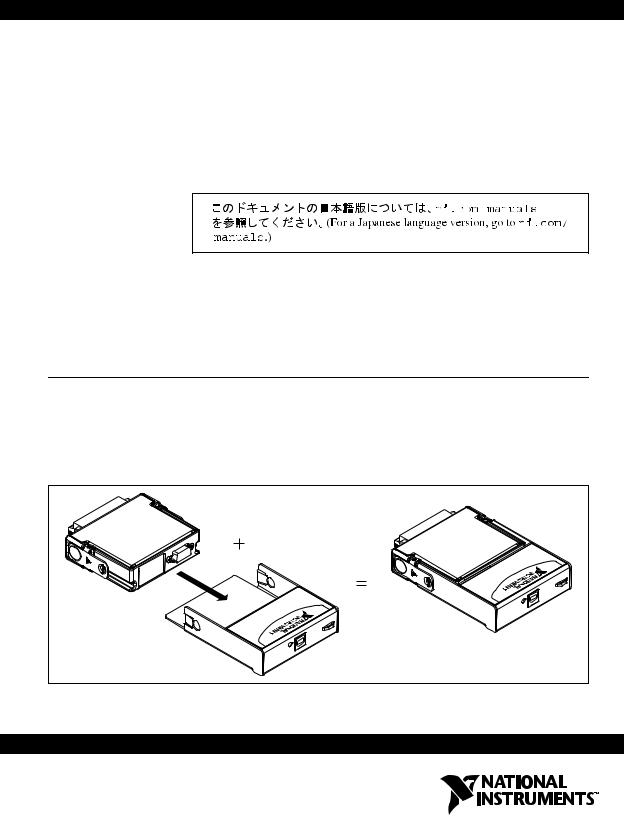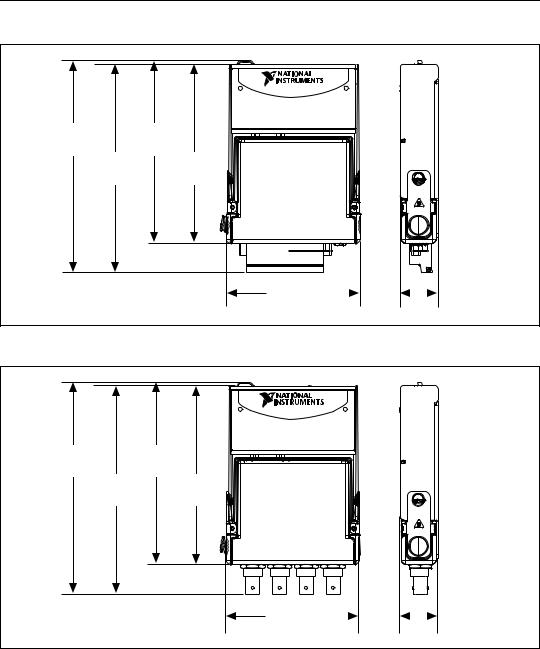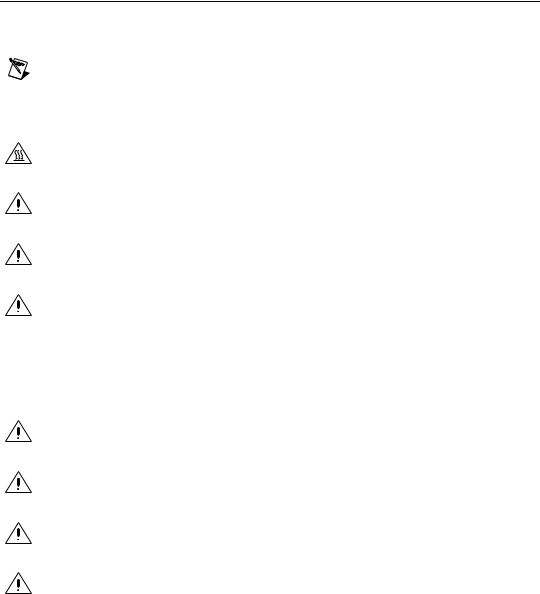National Instruments NI USB-9215 User Manual

USER GUIDE AND SPECIFICATIONS
NI USB-9215 Series
4-Channel, ±10 VDC, 16-Bit Simultaneous Sampling Analog
Input Devices
This user guide describes how to use the National Instruments USB-9215 Series and lists the specifications. In this document, the NI USB-9215/9215A with screw terminal or backshell and NI USB-9215A with BNC are referred to inclusively as the NI USB-9215 Series.
Introduction
The NI USB-9215 Series data acquisition devices provide a USB interface for four channels of 16-bit simultaneous sampling analog inputs with integrated signal conditioning. The NI USB-9215 Series consists of
two components: an NI 9215 module and an NI USB-9161/9162 USB carrier, as shown in Figure 1.
NI 9215 |
NI USB-9161/9162 |
NI USB-9215 Series |
Figure 1. NI USB-9215 Series Components

Dimensions
Figures 2 and 3 show the NI USB-9215 Series device dimensions.
Hi-Speed USB Carrier
NI USB-9162
140.23 mm |
120.68 mm |
|
(5.521 in.) |
(4.751 in.) |
|
137.82 mm |
118.26 mm |
|
(5.426 in.) |
(4.656 in.) |
|
88.12 mm |
|
|
25.34 mm |
|
(3.469 in.) |
|
|
|
(0.998 in.) |
|
|
|
|
|
Figure 2. NI USB-9215 (Screw Terminal) in Millimeters (Inches)
Hi-Speed USB Carrier
NI USB-9162
140.66 mm |
120.68 mm |
|
(5.538 in.) |
(4.751 in.) |
|
138.30 mm |
118.26 mm |
|
(5.445 in.) |
(4.656 in.) |
|
88.12 mm |
|
|
|
25.34 mm |
(3.469 in.) |
|
|
|
(0.998 in.) |
|
|
|
|
|
Figure 3. NI USB-9215 (BNC) in Millimeters (Inches)
NI USB-9215 Series User Guide and Specifications |
2 |
ni.com |

Safety Guidelines
Operate the NI USB-9215 Series only as described in these operating instructions.
Note Although the NI 9215 module may have more stringent certification standards than the NI USB-9215 Series, when used with the NI USB-9161/9162 carrier, the combined system may be limited. Refer to the Specifications section of this document for more details.
Hot Surface This icon denotes that the component may be hot. Touching this component may result in bodily injury.
Caution Do not disconnect I/O-side wires or connectors unless power has been switched off or the area is known to be nonhazardous.
Caution Do not remove modules unless power has been switched off or the area is known to be nonhazardous.
Caution The NI USB-9215 Series is not certified for use in hazardous locations.
Safety Guidelines for Hazardous Voltages
If hazardous voltages are connected to the module, take the following precautions. A hazardous voltage is a voltage greater than 42.4 Vpk or 60 VDC to earth ground.
Caution Ensure that hazardous voltage wiring is performed only by qualified personnel adhering to local electrical standards.
Caution Do not mix hazardous voltage circuits and human-accessible circuits on the same module.
Caution Make sure that devices and circuits connected to the module are properly insulated from human contact.
Caution When module terminals are live with hazardous voltages, make sure the terminals are not accessible by using the high voltage screw terminal backshell. Refer to the
Assembling the High Voltage Screw Terminal Backshell section for more information.
© National Instruments Corporation |
3 |
NI USB-9215 Series User Guide and Specifications |

Related Documentation
Each application software package and driver includes information about writing applications for taking measurements and controlling measurement devices. The following references to documents assume you have NI-DAQmx 8.7 or later, NI-DAQmx Base version 3.x, and where applicable, version 7.1 or later of the NI application software.
NI-DAQmx for Windows
The DAQ Getting Started Guide describes how to install your NI-DAQmx for Windows software, how to install your NI-DAQmx-supported DAQ device, and how to confirm that your device is operating properly. Select
Start»All Programs»National Instruments»NI-DAQ»DAQ Getting Started Guide.
The NI-DAQ Readme lists which devices are supported by this version of
NI-DAQ. Select Start»All Programs»National Instruments»NI-DAQ»
NI-DAQ Readme.
The NI-DAQmx Help contains general information about measurement concepts, key NI-DAQmx concepts, and common applications that are applicable to all programming environments. Select Start»All Programs»National Instruments»NI-DAQ»NI-DAQmx Help.
Note For information about non-Windows operating system support, refer to ni.com/info and enter BaseGSGML.
LabVIEW
If you are a new user, use the Getting Started with LabVIEW manual to familiarize yourself with the LabVIEW graphical programming environment and the basic LabVIEW features you use to build data acquisition and instrument control applications. Open the Getting Started with LabVIEW manual by selecting Start»All Programs»National Instruments»LabVIEW»LabVIEW Manuals or by navigating to the labview\manuals directory and opening LV_Getting_Started.pdf.
NI USB-9215 Series User Guide and Specifications |
4 |
ni.com |
Use the LabVIEW Help, available by selecting Help»Search the LabVIEW Help in LabVIEW, to access information about LabVIEW programming concepts, step-by-step instructions for using LabVIEW, and reference information about LabVIEW VIs, functions, palettes, menus, and tools. Refer to the following locations on the Contents tab of the LabVIEW Help for information about NI-DAQmx:
•Getting Started»Getting Started with DAQ—Includes overview information and a tutorial to learn how to take an NI-DAQmx measurement in LabVIEW using the DAQ Assistant.
•VI and Function Reference»Measurement I/O VIs and Functions—Describes the LabVIEW NI-DAQmx VIs and properties.
•Taking Measurements—Contains the conceptual and how-to information you need to acquire and analyze measurement data in LabVIEW, including common measurements, measurement fundamentals, NI-DAQmx key concepts, and device considerations.
LabWindows/CVI
The Data Acquisition book of the LabWindows/CVI Help contains measurement concepts for NI-DAQmx. This book also contains Taking an NI-DAQmx Measurement in LabWindows/CVI, which includes step-by-step instructions about creating a measurement task using the DAQ Assistant. In LabWindows™/CVI™, select Help»Contents, then select
Using LabWindows/CVI»Data Acquisition.
The NI-DAQmx Library book of the LabWindows/CVI Help contains
API overviews and function reference for NI-DAQmx. Select Library
Reference»NI-DAQmx Library in the LabWindows/CVI Help.
Measurement Studio
If you program your NI-DAQmx-supported device in Measurement Studio using Visual C++, Visual C#, or Visual Basic .NET, you can interactively create channels and tasks by launching the DAQ Assistant from MAX or from within Visual Studio .NET. You can generate the configuration code based on your task or channel in Measurement Studio. Refer to the DAQ Assistant Help for additional information about generating code. You also can create channels and tasks, and write your own applications in your ADE using the NI-DAQmx API.
For help with NI-DAQmx methods and properties, refer to the NI-DAQmx
.NET Class Library or the NI-DAQmx Visual C++ Class Library included in the NI Measurement Studio Help. For general help with programming in Measurement Studio, refer to the NI Measurement Studio Help, which is fully integrated with the Microsoft Visual Studio .NET help. To view
© National Instruments Corporation |
5 |
NI USB-9215 Series User Guide and Specifications |
this help file in Visual Studio. NET, select Measurement Studio» NI Measurement Studio Help.
To create an application in Visual C++, Visual C#, or Visual Basic .NET, follow these general steps:
1.In Visual Studio .NET, select File»New»Project to launch the New Project dialog box.
2.Find the Measurement Studio folder for the language you want to create a program in.
3.Choose a project type. You add DAQ tasks as a part of this step.
ANSI C without NI Application Software
The NI-DAQmx Help contains API overviews and general information about measurement concepts. Select Start»All Programs»National Instruments»NI-DAQ»NI-DAQmx Help.
The NI-DAQmx C Reference Help describes the NI-DAQmx Library functions, which you can use with National Instruments data acquisition devices to develop instrumentation, acquisition, and control applications. Select Start»All Programs»National Instruments»NI-DAQ» NI-DAQmx C Reference Help.
.NET Languages without NI Application Software
With the Microsoft .NET Framework version 1.1 or later, you can use NI-DAQmx to create applications using Visual C# and Visual Basic
.NET without Measurement Studio. You need Microsoft Visual Studio
.NET 2003 or Microsoft Visual Studio 2005 for the API documentation to be installed.
The installed documentation contains the NI-DAQmx API overview, measurement tasks and concepts, and function reference. This help is fully integrated into the Visual Studio .NET documentation. To view the NI-DAQmx .NET documentation, go to Start»Programs»National Instruments»NI-DAQ»NI-DAQmx .NET Reference Help. Expand
NI Measurement Studio Help»NI Measurement Studio .NET Class Library»Reference to view the function reference. Expand
NI Measurement Studio Help»NI Measurement Studio .NET Class Library»Using the Measurement Studio .NET Class Libraries to view conceptual topics for using NI-DAQmx with Visual C# and Visual Basic
.NET.
To get to the same help topics from within Visual Studio, go to
Help»Contents. Select Measurement Studio from the Filtered By drop-down list and follow the previous instructions.
NI USB-9215 Series User Guide and Specifications |
6 |
ni.com |

Device Documentation and Specifications
NI-DAQmx includes the Device Document Browser, which contains online documentation for supported DAQ and SCXI devices, such as documents describing device pinouts, features, and operation. You can find, view, and/or print the documents for each device using the Device Document Browser at any time by inserting the CD. After installing the Device Document Browser, device documents are accessible from Start»
All Programs»National Instruments»NI-DAQ»Browse Device Documentation.
Note You can download these documents at ni.com/manuals.
NI-DAQmx Base (Linux/Mac OS X/LabVIEW PDA 8.x)
The NI-DAQmx Base Getting Started Guide describes how to install your NI-DAQmx Base software, your NI-DAQmx Base-supported DAQ device, and how to confirm that your device is operating properly. In Windows, select Start»All Programs»National Instruments»NI-DAQmx Base» Documentation»Getting Started Guide.
Getting Started with NI-DAQmx Base for Linux and Mac Users describes how to install your NI-DAQmx Base software, your NI-DAQmx Base-supported DAQ device, and how to confirm that your device is operating properly on your Mac/Linux machine.
The NI-DAQmx Base Readme lists which devices are supported by this version of NI-DAQmx Base. In Windows, select Start»All Programs» National Instruments»NI-DAQmx Base»DAQmx Base Readme.
The NI-DAQmx Base VI Reference Help contains VI reference and general information about measurement concepts. In LabVIEW, select
Help»NI-DAQmx Base VI Reference Help.
The NI-DAQmx Base C Reference Help contains C reference and general information about measurement concepts. In Windows, select Start»All
Programs»National Instruments»NI-DAQmxBase»Documentation» C Function Reference Help.
Note All NI-DAQmx Base documentation for Linux is installed at /usr/local/ natinst/nidaqmxbase/documentation.
Note All NI-DAQmx Base documentation for Mac OS X is installed at
/Applications/National Instruments/NI-DAQmx Base/documentation.
© National Instruments Corporation |
7 |
NI USB-9215 Series User Guide and Specifications |
